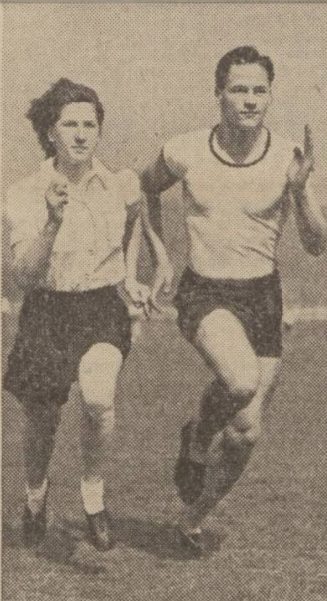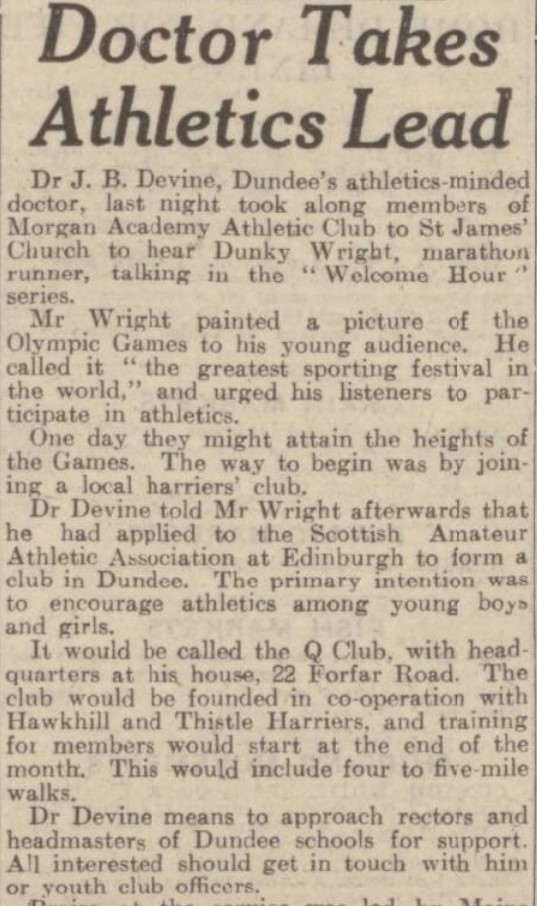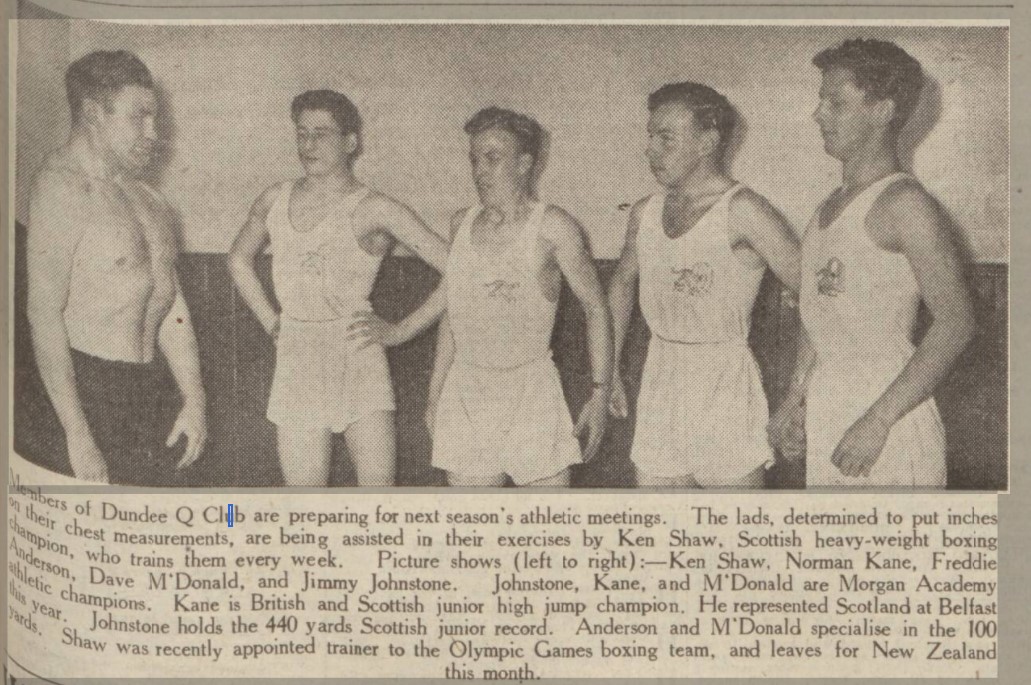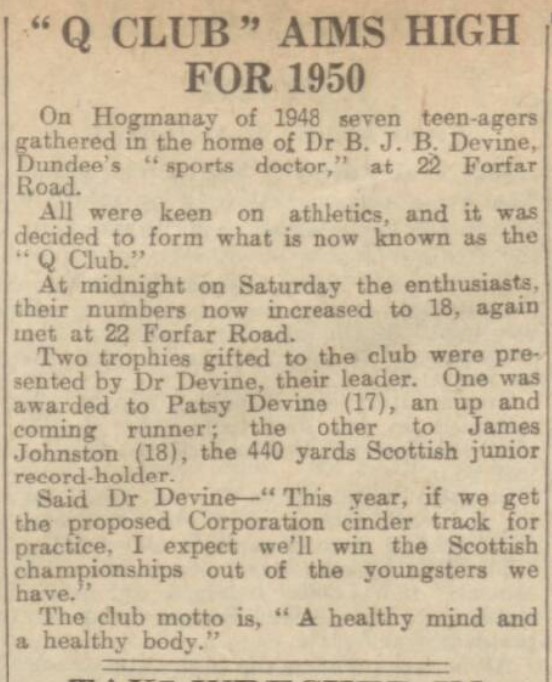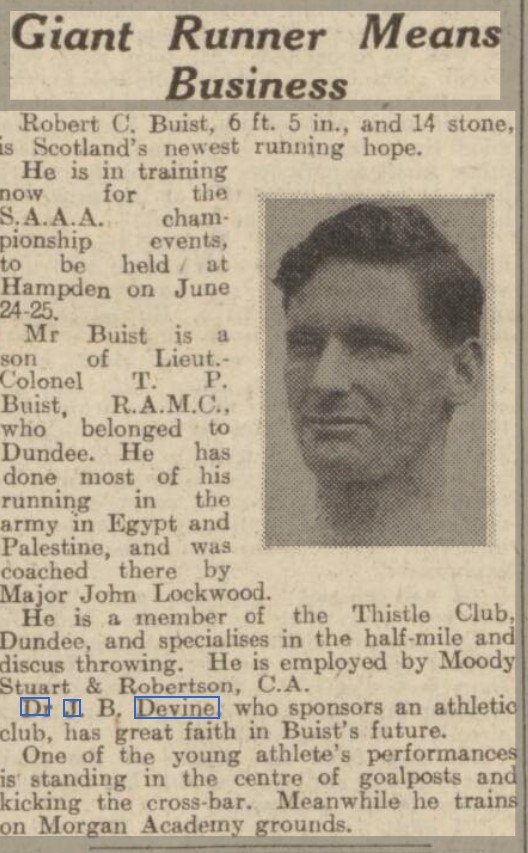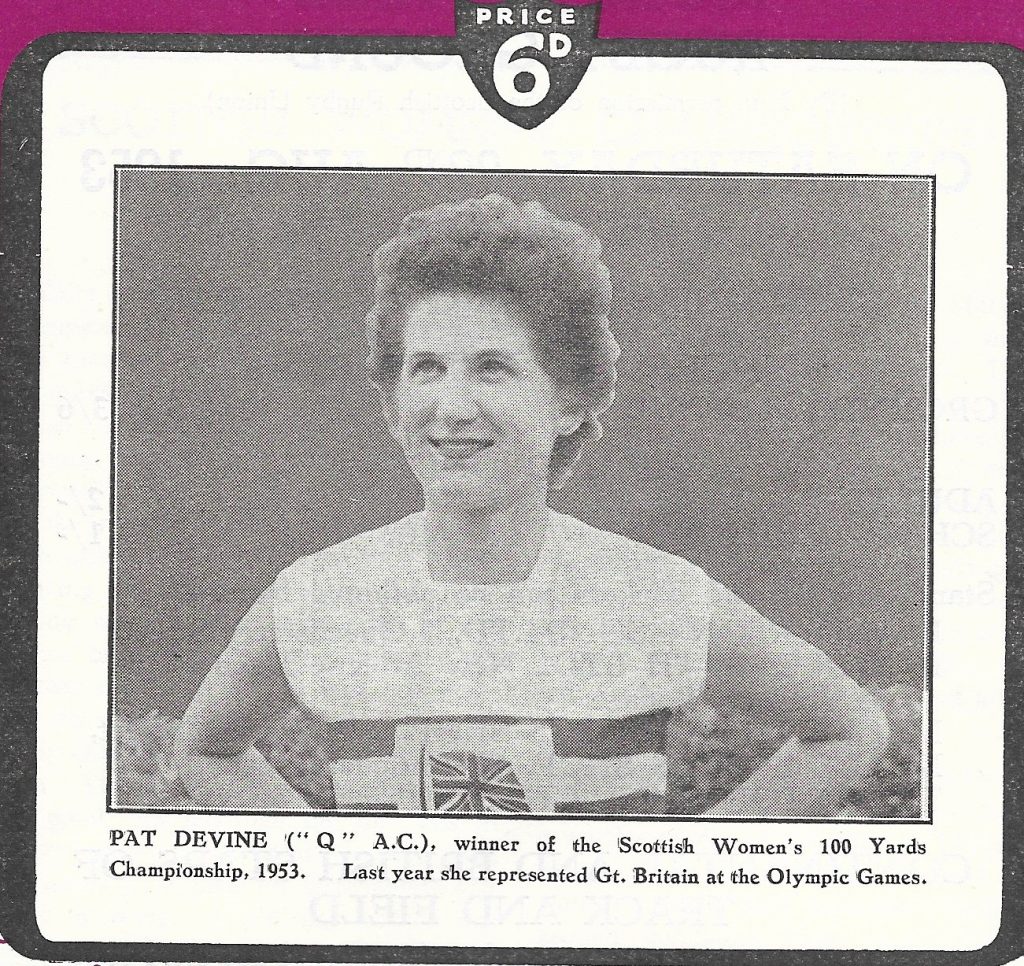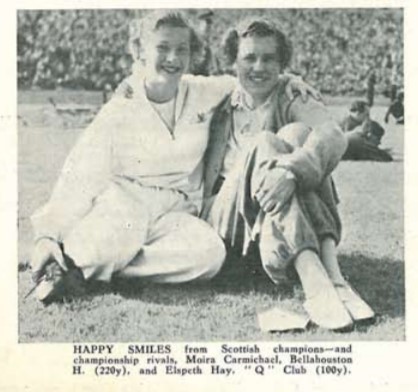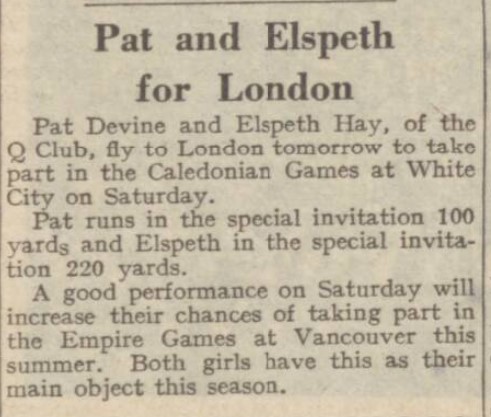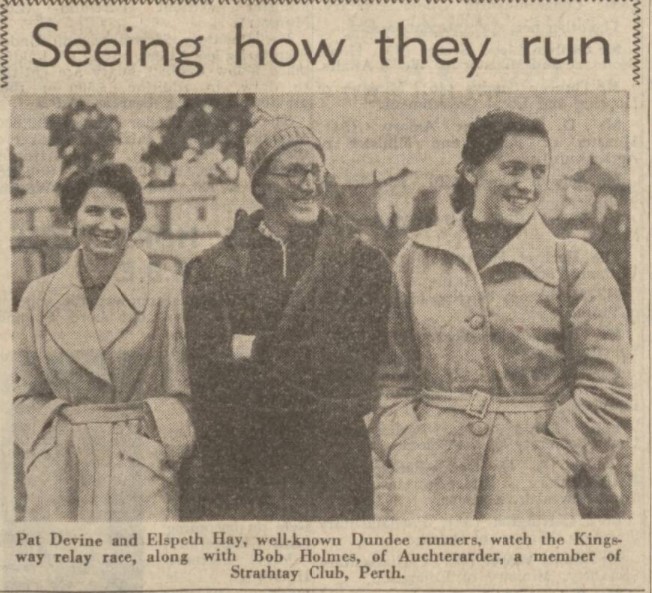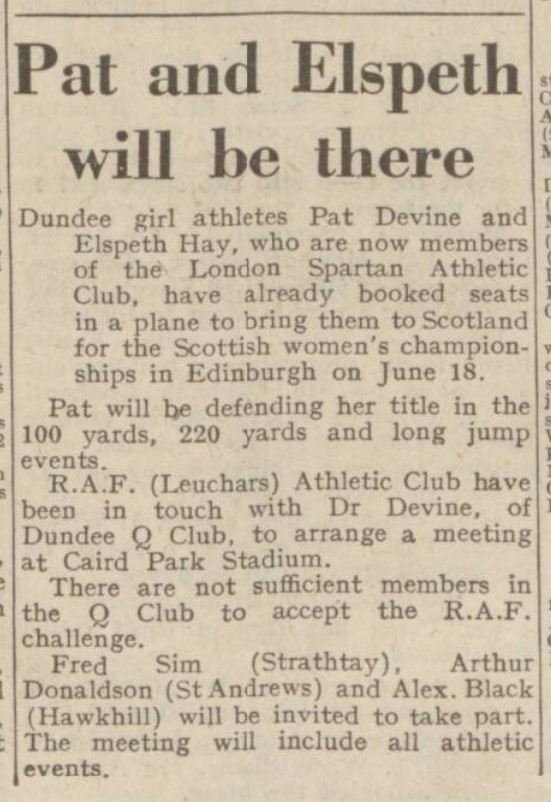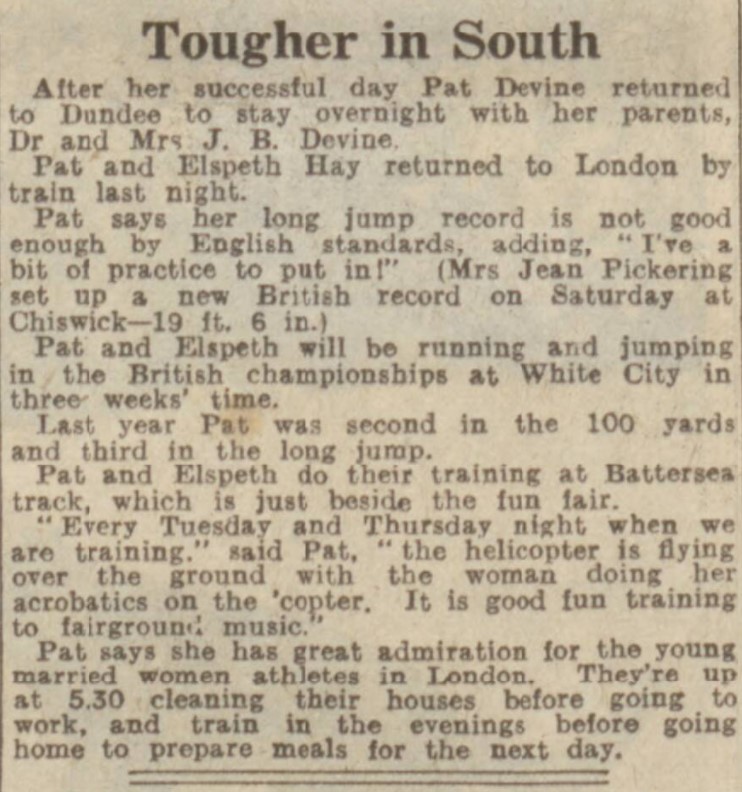The Q Club was formed by Dr J Bernard Devine when he was pushing hard for a running track in Dundee in the late 1940’s and early 1950’s. A short lived club, and entirely track & field oriented, it was part of the movement and should be read in conjunction with the account of the struggle for the Caird Park facility which will appear shortly.
A spot of running practice at the school grounds by sister and brother, Pat and Brian Devine of Morgan Academy, Dundee. Pat holds the intermediate championship. Their father is Dr J Bernard Devine.
Arthur Lydiard said quite frequently that there are champions everywhere, they just need to be found. He proved his point when he turned out first class athletes in New Zealand, Mexico, Finland and anywhere he went. The claim is supported by the performance of the short lived and little known Q Club in Dundee which only lasted from 1948 to 1958. A man not previously involved in athletics wanted to improve facilities for his son and daughter and following a campaign for the facilities, formed the Q club which produced two Olympians, as well as several British and Scottish Champions, record holders. The man in question was Dr J Bernard Devine his daughter was Pat )initially Patsy, occasionally Patricia, but usually Pat) and his son Brian. The story starts when Pat was a pupil at Morgan Academy, Dundee as was Brian, two years older.
The story starts with a short article in the Dundee Courier of 12th June 1948 reporting Pat Devine’s success in the Olympic trial Long Jump two days earlier. She was noted as the daughter of Dr J Bernard Devine of 22 Forfar Road, Dundee. Her father always had his title and almost always had his address when mentioned in the Press. There followed a campaign to get a running track and athletics facility in the town with Dr Devine playing a leading part. The story of the track is elsewhere on this website but it should be noted that there were meetings with councillors on 12th July (Dundee Needs a Sports Ground), 9th November (Devine Urging …) and 14th February 1949 (Doctor Takes Athletics Lead) with the whole story at this link.
The Doctor meant business and he was to keep on at the council and the Press about a track for the young athletes in the town. Morgan Academy had a record of turning out good sports people so there were more parents who were interested in such provision and of course there was a supply of potential users of such a facility.
He went further and at a meeting in February 1948 at a meeting addressed by Dunky Wright he announced that he had applied for the SAAA to recognise the establishment of a new club to be called Q Club. Why the Q Club? – It still seems an unusual name. To the best of our knowledge, nobody has ever said. The coach at the club however was Jack Quisklay from the University College of Dundee who was also a well-known official and there me be a clue there.
The young athletes had been performing well for Morgan Academy before the club was set up. For the first time ever, the school defeated George Heriot’s in a competition with names like David Findlay, Brian Devine, Norman Kane and JB Sclater all on duty. Patsy Devine had been second in the Olympic Trial on 12th June, Then David Findlay won the Scottish Schools 440 yards 52,3 and in the School Championships, Patsy won the high jump with a 4’ 8 ¼” clearance and Findlay won the Discus with a throw of 123’ 8” which broke a record which had stood for 12 years.
The youngsters all joined the new club in time for the major championships of the summer. Norman Kane who was to go on to great things as a high jumper won with a5’ 10” jump and Jim Johnston won the 440 in a time of 52.0 seconds which was a championship best performance. There was reference to the fact that Kane had ‘topped his own height’ in the high jump and comments about his short stature for a high jumper would continue for as long as he was a serious competitor.
In the Senior Championships at the end of June, RC Buist who had joined the club from Dundee Thistle Harriers was third in the Shot Putt and he would go on to win gold in later years for the Discus. There was no complete SWAAA Championships but there were women’s championships with limited events and Patsy was third in the 100 yards.
Norman Kane’s 1949 season got better with every passing week – having won the SAAA’s high jump, he won the AAA’s high jump in August 1949 and then, in open competition leapt an astonishing 6’ 0”.. By the end of the year he topped the British Junior rankings.
In an article headed GREAT SCOTS IN AAA JUNIOR CHAMPIONSHIPS in the magazine in August 1949, Farrell said “Norman Kane (Q Club) again cleared 5’ 10” as he did in the Scottish Championships, an exceptional leap, especially by a lad of middle height.” Further through the same issue the headline was “KANE CLEARS 6 FEET” and the article was as followsL “In the meeting promoted by the SAAA at Ibrox on the Tuesday following the Rangers Sports, on behalf of the Empire Games Fund, there were some grand exciting contests. Dual Scottish and AAA’s junior champion Norman Kane put up his greatest performance by clearing 6 feet in the high jump which, with his handicap, made him the winner of the event.”
The photograph below from the Dundee Courier shows Kane second from left.
The only Senior Man to win a medal at the Scottish Championships in 1949 was Robert Buist who covered the unusual double of half mile and throws events. He won medals of gold, silver and bronze at one time or another at all three of 880 yards, discus and shot putt and was ranked in the top ten for both shot and discus over a period of years in the 1950’s. When the club eventually ceased to exist in the late 1950’s he switched to the Field Events Club. The article below, from the ‘Dundee Courier’, gives more detail on the man.
More information about the club and its ambitions appeared in the ‘Dundee Courier of Tuesday 3rd January, 1950 in the following short article:
Note that the ‘sports doctor’ did not hope that the club would win the Scottish championships (whatever that means) but expected that they would. He also expected work and assistance from all quarters. In February the newly appointed National Coach Tony Chapman came to Dundee and conducted the examinations for the appropriate coaching awards and on the first day, Norman MacLeod (Thistle Harriers), G Neil, (Hawkhill Harriers) and Brian Cloag and Gordon Campbell of Q Club and J Stevenson of Training College all gained their awards. Cloag was also a member of the YMCA Fencing Team so the net was being cast far and wide. There were three more coaches presented with their awards the following day – Mr AW Campbell, director of physical education, St Andrews, Andrew ???, Carnoustie and CPO Robertson, HMS Cressy; in the afternoon Mr Derrington of University College, RC Buist of Q Club. V Lyons of Thistle Harriers, JC Pont, unattached and H Brankin, NCR and Q Club all passed.
There was a new club member for the season who would serve the club well for several years – Elspeth Hay came from Bridge of Earn and had been chosen for the 1948 British Olympic team. Injured in the training for the relay team, she could not take part however and in 1950 she joined the Q Club.
In the SAAA Championships held at New Meadowbank on 23rd and 24th June, 1950, JC Buist qualified for the final of the 880 yards where he finishedfourth and just out of the medals in 2:02. He also took part in the Discus where his best for the day was over the 110’ mark which was the qualifying distance for the Association’s standard award. On the same day at the same venue the club Junior Men’s team was third in the 4 x 110 yards relay. Earlier in June, the first official SWAAA Track & Field Championships since 1939 were held, and Pat Devine and Elspeth Hay did the club proud in their respective events. Elspeth won the 100 yards in 11.6 seconds with Pat a close-up third. Pat then won the long jump with 17’ 9 ¼” . Elspeth Hay had been a good signature for the club and when she joined, the ‘Courier’ reports with a photo and a short caption.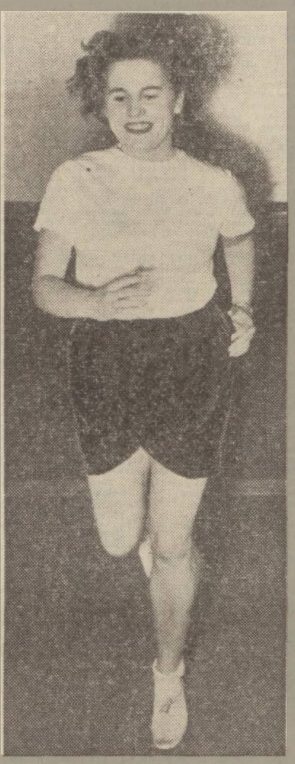
“Elspeth Hay, Bridge of Earn is the latest recruit to Dundee’s athletic Q Club. She ran at the Hampden Park Sports Meeting last season and specialises in the 220 yards race. It is the intention of the girls section of Q Club to build up a strong relay team next season and with runners like Elspeth Hay, Pat Devine and Ann Brown of Arbroath, they should take a lot of stopping.”
In August, 1950, the European Championships were held in the Heysel Stadium in Brussels on the 24th and 25th, and Elspeth Hay was there. Second in the second heat of the 100 metres in 12.5, she qualified for the final where she was fifth against a very good field –
- F Blankers-Koen 7; 2. Y Sechenova (Russia) 12.3; 3.June Foulds (GB) 12.4; 4. Z Dukhovic (Russia) 12.4; 5. E Hay 12.5; 6. C Aitelli (France) 12.5
Note that second to fifth were covered by 2 tenths of a second! Two days later Elspeth ran in the 200m where she was third in her Heat (25.5) and did not qualify for the final. Her big moment of triumoh however came on 27th August when she ran the first leg of the sprint relay followed by Jean Desforges, Dorothy Hall and June Foulds to be part of the winning team. Q Club had a European gold medal. It was a close run thing: Britain won in 47.4, Netherlands was second, also in 47.4 and the Soviet Union was third in 47.5. Pat Devine had also taken part in the championships but could only finish 14th in the long jump, well below her best – her typical form would have seen her as a contender for a medal.
In June 1951 writing in his column in The Scots Athlete, Emmet Farrell said that “RC Buist ‘should again be a strong challenger in the half mile” and noted that “Elspeth Hay is a grand performer.” They showed this in all their competitions that year and in the SWAAA Championships at New Meadowbank on 9th June the report in the Mid-Summer issue of the Scots Athlete said “Miss E Hay (Q Club) gained the narrowest of victories from Miss M Carmichael (Bellahouston) but I feel from what I have seen that Elspeth has yet to find her best form this season. Miss P Devine, also of the Q Club, was a very good third in a thrilling final.” Pat also won the long jump where, into a headwind, she cleared 16’ 7”.
1952 was to be the top year for Pat Devine and Elspeth Hay with major international selections for both. But what of the Q Club. It had been doing well and had proved that it could spot talent and help develop that talent but many of the very good athletes who had represented the club were nowhere to be seen a mere three years after the club came into existence. Norman Kane, Scottish and British High Jump champion just disappeared the following year, the young hurdler David Findlay we know went in to the army, possibly on National Service but nothing was heard of him subsequently and others also disappeared. Society was different then, but there seemed to be difficulty in retention.
In August, 1950, the European Championships were held in the Heysel Stadium in Brussels on the 24th and 25th, and Elspeth Hay was there. Second in the second heat of the 100 metres in 12.5, she qualified for the final where she was fifth against a very good field –
- F Blankers-Koen 7; 2. Y Sechenova (Russia) 12.3; 3.June Foulds (GB) 12.4; 4. Z Dukhovic (Russia) 12.4; 5. E Hay 12.5; 6. C Aitelli (France) 12.5
Note that second to fifth were covered by 2 tenths of a second! Two days later Elspeth ran in the 200m where she was third in her Heat (25.5) and did not qualify for the final. Her big moment of triumph however came on 27th August when she ran the first leg of the sprint relay followed by Jean Desforges, Dorothy Hall and June Foulds to be part of the winning team. Q Club had a European gold medal. It was a close run thing: Britain won in 47.4, Netherlands was second, also in 47.4 and the Soviet Union was third in 47.5. Pat Devine had also taken part in the championships but could only finish 14th in the long jump, well below her best – her typical form would have seen her as a contender for a medal.
They had been the first Scottish women to compete for GB in a major Games meeting with Elspeth being the very first since her Heat of the 100 yards was 45 minutes before Pat’s long jump.
The club men put up a better show in 1952 in that there were medals in the SAAA Junior and SAAA Men’s Championships (one in each) and another was ranked among the best at the end of the year. In the SAAA Championships on 6th and 7th June, RC Buist was second in the Discus with a throw of 123’ 9 ½” and in the Junior Championships AR Donaldson was third in the long jump. In the rankings of best Scottish performers that year Buist was sixth in the discus with his championships throw and JL Donnelly was fifth in the Putting the Weight lists with 40’ 9”as his best. Only Elspeth won anything in the SWAAA event being second in the 100 and third in the 220 yards. But 1952 was important as an Olympic Year and as a Britih Commonwealth Games year. Pat was selected for them and ran in the 200m where she was third behind Marjorie Jackson (Australia) and Catherine Hardy of the United States in the third Heat and failed to make the final. She had now competed in both European and Olympic Games for Great Britain.
Yjere had been major Games in 1950 and 1952 but 1953 was a fallow year as far as International Games Meetings were held although there were both British Commonwealth and European Games in 1954. 1953 was a time when serious work could be done and also a chance to catch the selectors’ eye early. Again it was a year when the men’s side of the club performed poorly in terms of track and field championships were concerned although at the end of the year both Buist (4th, discus) and Donnelly (3rd Disuus, 5th shot) were ranked nationally.
In the SWAAA Championships, however, the ladies performed well. This time Pat Devine won the 100 yards in 11.5 second with Elspeth second a mere couple of feet away. Both women made the final of the 229 yards but neither was placed. Pat was also third in the final of the80m hurdles and then in her specialist event, the long jump, she was second. The club members were competing all summer of course and in the Glasgow Police Sports Pat was third in the invitation long jump behind the English and Dutch jumpers and in the Edinburgh Highland Games, Pat was third in the 100 yards and Elspeth was third in the 220.
In the SAAA Junior Championships, another young Q Club member, NR Buist, won two medals – first in the 120 yards hurdles in 17.5 seconds and third in the high jump with a clearance of 5’6” he was the only male athlete from the club to win anything in either the Junior or Senior Championships that year.
One month later, in the Triangular International in Dunoon, Elspeth Hay was third in the 100 yards behind two very good English women while Pat Devine won the long jump with 17’ 7 ½”. Scotland also won the 4 x 110 yards relay with a team of M Carmichael, Hay, Shivas and Devine.
1954 was the big year for Pat Devine and for Q Club with all the usual open meetings plus the national championships in all age group and the big target for the top athletes, the British Empire Games in July and the European Championships in August. The names of Devine and Hay were well-known throughout Britain – hadn’t they both competed at European and Olympics? The Courier in May carried an article
The new Caird Park track was officially opened on 5th June with both cycling (on the tarmac outside track) and athletics on the cinder track. Most of the local athletes took part and the meeting was a great success. Given the work done by several of the club committee it was particularly gratifying to the Q Club.
The year progressed with both men’s and women’s national championships held in June and both at New Meadowbank. In the SWAAA event on 12th June, the ‘popular Q Club member, Pat Devine was the winner of three events@ yje 100y in 11.1 from Elspeth Hay, the 220y in 25.1 from Elspeth, and the long jump with 17’ 3 1/2″, Elspeth was second in the Shot Putt and a third club member, I Smith, won a standard award in the discus. In the SAAA championships on 25th and 26th June, J Johnston was sixth in the 440y in 51.6, LKA Duncan was a finalist in the 880y, NRM Buist ran 16.4 in his heat of the 120y hurdles and won a standard medal, JL Donnelly was second in the discus and fourth in the shot and RC Buist was third in the discus and fourth in the shot.
By the end of the 1954 season, Donnelly was ranked number four in Scotland for the shot putt with RC Buist seventh; a,d in the discus Donnelly was third and Buist fifth.
Pat had done well in the AAA’s championships being runner up in the 100 yards and fourth in the 220 and long jump. It was a time when the British women’s sprinting was on a high with athletes like June Foulds, Heather Armitage, Jean Desforges (later Pickering) running consistently well. Following the championships, the team was selected for the British Empire Games held in the Vancouver between 30th July and 7th August and Pat was selected for the 100 yards, 220 yards and long jump. In the 100 she was 5th in Heat 1 in 11.1 seconds and did not qualify, third in Heat 2 of the 220 in 25.7, and did not turn out in the long jump. Came the European championships in the Berne, Sitzerland, and Pat was part of the GB team that was competing between 26th and 27th August. She performed noticeably better here than in Vancouver. In the 100 metres she was third in Heat 3 in 12.5 and in the 200 metres she won the first Heat in 24.9 and progressed to the semi-final where she was narrowly run out of the final. There were three to qualify for the six runner final and the finishing times of the first four in order were 24.3, 24.4, 24.8, and 24.8. She had the same time as the third placed runner, four tenths behind second. Most unlucky.
She was a bit of a celebrity when she returned and along with Elspeth was a guest of honour at local functions. eg Pat along with Joe McGhee were invited to the Aberfeldy Meeting but the plane home was too late for them to attend. The picture below shows Pat and Elspeth at one of the least glamorous of these!
In the Scottish Men’s championships on 25th and 26th June, 1955, only one Q Club members won any medals. JJ Donnelly was second in the Shot Putt and third in the discus. No Juniors or Youths were noted in the Press as taking part. But the women’s championships produced a surprise – or two. In May of 1955 the following article appeared in the ‘Courier’ and, in addition to the information about the two sprinters contains the information that the club did not have enough members to compete in an inter-club match. Given the recruiting possibilities in the town and the apparent enthusiasm of Dr Devine and his coaches, it is perhaps surprising.
The local paper, the ‘Dundee Courier’ announced “Pat Flies North To Take Three Titles” before an opening paragraph which read “Three records were set up in the Scottish women’s championships in Edinburgh on Saturday. Pat Devine (Q Club and Spartan Ladies)who flew up from London for the championships along with Elspeth Hay, did 17′ 11” in the long jump beating the previous record by half an inch.!
The ‘Courier’ may have said Q Club and Spartan Ladies but almost every other paper as well as the ‘Scots Athlete’ magazine simply had them as ‘Spartan Ladies’ which was a London ladies athletic club. In the event, Pat also won the 100 yards in 11.6, and the 220 yards in 26.4.Elspeth was second in both sprints and third in the shot putt. Away from the championships, Pat had also been trying her hand at the 440 yards distance and ran in it at the Cowal Highland Games. The Glasgow Herald reported on the event on 25th August, saying “The women’s 440 yards was arranged specially for Miss JG Herman (Edinburgh Southern Harriers) but she found Miss P Devine (Q Club) too much for her at the crucial stage of the race. The Dundee girl, a sprinter of repute, produced a better finish and beat Miss Herman by a couple of yards in the fine time of 58.5 seconds, or .2 seconds behind the native record made by Miss Herman at the national championships. Miss Herman made the mistake of going too fast over the first furlong. Miss Devine was as much as five yards behind at the first half of the race.” Would we see a move up in distance for Pat.
Pat and Elspeth had however really decided that if they wanted to progress their athletics, they had to move to London. This appeared in the ‘Courier’ on 13th June.
The last sentence is an interesting one regardless of the rest of the article!
One of the the first meetings in 1956 was an eight club match at Caird Park organised by Hawkhill Harriers on Wednesday, 23rd May when the star sprinter was Doris Tyndall of Tayside AAC and the only Q Club athlete mentioned was sprinter M Mitchell who won the 100 yards. But even if none of their athletes were named in the very brief report the Q Club was second team behind Tayside. The Tayside Club, part organised by Andy Coogan who had been a member of Maryhill Harriers before the War and was a Japanese prisoner of war , won both men’s and women’s competitions and Q was second in both. In mid-July there was another six-sided competition with Hawkhill, Tayside, Q Club, Arbroath , Perth Strathtay and Broughty Ferry. Q qas fifth club this time out and the only athlete from the club to finish in the first three was M Mitchell (2nd in 100, 1st in 220).
In between were the national championships and there were no athletes from the Q Club in among the medals in the SWAAA championships, and in the men’s championships RC Buist at last won the gold medal for the discus with a best of 137′ 7″ with J Donnelly fifth’ in the shot putt, Buist was fourth . There was no athlete from the club in the Youth or Junior events.
There was a similar pattern to events in 1957. The inter club on 18th May featured only M Mitchell of Q Club with Doris Tyndall of Tayside being the star runner. Tayside AAC held a meeting at the start of July in Carnoustie and again the only Q Club runner was M Mitchell and the club finished last of the six teams competing. Sports were held by Dundee North End FC on 20th July, and only Maureen Mitchell represented Q club with any success. There were no women or young athletes in either of their national championship meetings, and only one (former) Q representative in the SAAA Championships at New Meadowbank on 22nd /23rd June. RC Buist was third in the Discus throw – but this time he was entered as a member of the Field Events Club.
Q Club seemed to have gone from a national club to a local club. On its last legs in 1957, it had ceased to exist by 1959. A purely track and field club, organised pretty well by one man who had two talented children it was allowed to decline after the two top women athletes moved to London where they ran for Spartan Ladies AC. It was a pity that it went.
…..
